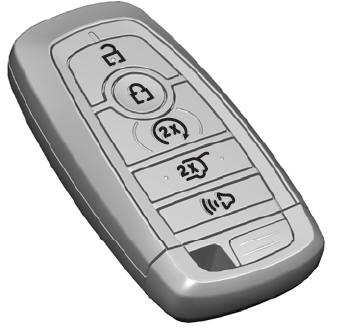Lincoln Aviator: All-Wheel Drive / How Your Vehicle Differs from Other Vehicles
Truck and utility vehicles can differ from some other vehicles. Your vehicle could be higher to allow it to travel over rough terrain without getting hung up or damaging underbody components.
The differences that make your vehicle so versatile also make it handle differently than an ordinary passenger car.
Maintain steering wheel control at all times, especially in rough terrain. Since sudden changes in terrain can result in abrupt steering wheel motion, make sure you grip the steering wheel from the outside. Do not grip the spokes.
Drive cautiously to avoid vehicle damage from concealed objects such as rocks and stumps.
You should either know the terrain or examine maps of the area before driving. Map out your route before driving in the area. To maintain steering and braking control of your vehicle, you must have all four wheels on the ground and they must be rolling, not sliding or spinning.
 Operating ALL-Wheel drive (AWD) Vehicles with Mismatched Tires
Operating ALL-Wheel drive (AWD) Vehicles with Mismatched Tires
WARNING: Only use replacement
tires and wheels that are the same size,
load index, speed rating and type (such as
P-metric versus LT-metric or all-season
versus all-terrain) as those originally
provided by Ford...
 Driving in Special Conditions With All-Wheel Drive (AWD)
Driving in Special Conditions With All-Wheel Drive (AWD)
Note: Use of the AWD system in slippery,
deep snow and sand drive modes on dry
surfaces could produce some vibration and
driveline bind up and, or excessive tire wear,
as the intent of these drive modes are for
slippery and loose surfaces...
Other information:
Lincoln Aviator 2020-2025 Service Manual: Description and Operation - Message Center - System Operation and Component Description
System Operation System Diagram Item Description 1 BCM 2 Door/liftgate ajar switches 3 GWM 4 Fuel pump and sender unit 5 IPC 6 APIM 7 Washer fluid level switch 8 Message center display 9 IPMA 10 PCM 11 Engine oil pressure sensor 12 Ambient air temperature sensor 13 AWD module 14 ABS module 15 PAM 16 IPMB 17 Brake fluid level switch 18 Hood ajar switch 19 RH steering wheel switch 20 SCCM 21 SIMA 22 SODL 23 DCMG 24 DCMH 25 HCM 26 RCM 27 PSCM 28 GSM 29 SODR 30 HVAC module 31 TRM 32 DSM 33 DCME 34 DCMF Network Message Chart Module Network Input Messages - IPC Broadcast Message Originating Module Message Purpose Active park assist warning message request IPMB (with 360° camera)/ PAM (without 360° camera) Input used to display the active park assist warning message...
Lincoln Aviator 2020-2025 Service Manual: Description and Operation - Transmission Cooling - Overview
Transmission Cooling The transmission fluid cooling system consists of a heat exchanger mounted to the transmission. Transmission fluid cooler tubes connect the transmission to the heat exchanger. The heat exchanger has both transmission fluid and engine coolant flowing through it in separate chambers...
Categories
- Manuals Home
- Lincoln Aviator Owners Manual
- Lincoln Aviator Service Manual
- Anti-Theft Alarm
- Keyless Entry
- Drive Modes
- New on site
- Most important about car
Remote Control
Passive Key

The passive key operates the power locks and the remote start system. The passive key must be in your vehicle to use the push button start.
Note: You may not be able to shift out of park (P) unless the passive key is inside your vehicle.
